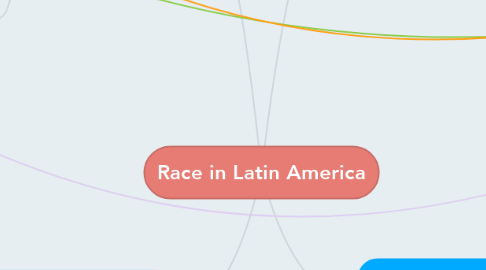
1. Asian Immigration to Latin America
1.1. Spanish America and the Initial Formation of the Pacific
1.1.1. Established the Manila galleon trade lasted three centuries
1.1.1.1. Liking China and Japan via Philippines to Europe in an exchanged of Mexican silver for Oriental luxury goods
1.1.1.2. The First Asian colony in Americas appeared.
1.2. Chinese Coolie Labor in Cuba and Peru
1.2.1. Peru became independent of Spain in the middle of the nineteenth century, and Cuba remained a Spanish colony in the Caribbean.
1.2.1.1. Promoted the importation of Chinese coolies or contract laborers to work on sugar plantations
1.2.2. As many as 250,000 Chinese coolies under eight-year contracts were sent to Peru and Cuba with 80% or more destined for the plantations from 1847 to 1874.
1.2.3. The first experiment with the exporting of Chinese then East Indian were the British.
1.2.3.1. 200 Chinese were sent to Trinidad when the British ended the slave trade as early as 1806
1.2.4. The peruvian Government paid about 450,000 pesos in premiums to encourage transportation of foreign labor for the sugar plantations from 1839 to 1851
1.2.5. The size of the coolie imports rose markedly reaching as many as 12,391 and 14,263 in 1866 and 1867 as the African slave trade wound down and ended with the last shipment in 1865
1.2.6. Recontracting took a significant nre turn, beginning as early as 1870 in Cuba and appearing around 1880 in Peru
1.2.6.1. The new contracting system involved a free Chinese operating as an enganchador
1.2.7. Other Asia-Pacific Labor in America
1.2.7.1. To compare the emigration of Japanese labor to Chinese labor into Latin America, as into the United States, was much more closely regulated and supervised by the Japanese government
1.2.7.1.1. The majority of Japanese immigrants to Latin America arrived initially also as contract laborers on coffee in Brazil, sugar plantations in Peru, and rubber plantations in Bolivia
2. Afro-Mexicans
2.1. Colombia has the largest black populations in Latin America
2.2. development of black organizations
2.2.1. the emergence of organizations that alluded more assertively to blackness, and it mainly work of small urban intellectual elite
2.2.1.1. such like: university students, graduates who identified as black and were influenced by racial movements in other places
2.2.2. focus on other experiences and notions of blackness to inform their own position
2.2.3. cultural politics that go beyond the simple oppositions between colonizer and colonized
2.2.3.1. need to understand the sketch in background in that two areas
2.3. the new Constitution captained clauses recognizing the "multiethnic and pluricultural"character of the nation
2.3.1. people seeking to push blackness into the political arena
2.3.1.1. made to "black communities"
2.3.2. black organization refusing to assist government until that the government had fulfilled its obligation as state in the new Constitution and fully guaranteed the real participation of black communities
2.3.2.1. the law recognized "black" as an ethnic group
2.4. "political economy" made clear identification on the political contexts.
2.4.1. example: indigenous people ➡ identity was institutionalized
2.4.2. example: blacks in Colombia ➡ identity was NOT institutionalized
2.5. "blackness" as a properly political process
2.5.1. Colombia: an authentic black identity was by showing the political contexts
3. Rethinking Race in Brazil
3.1. New racial patterns and processes are emerging
3.1.1. including political, cultural, economic, social, and psychological
3.2. UNESCO --- United Nations Educational, Scientific and Cultural Organization
3.2.1. the UNESCO-sponsored research set new terms for debate, constituting a new racial "revisionism"
3.3. UNESCO researchers they doing as never before the prevalence of racial discrimination, and the persistence of the ideology of "whitening"
3.3.1. The racial theory they employed was less innovative.
3.3.2. unprecedented
3.3.3. race was interpreted in terms of class
3.3.4. racial dynamics were simply support the capitalist development in Brazil; racial revisionism was full of insights into it but it had limitations
3.4. the impact of democratization
3.4.1. it was a beginning of re-emergence of civil society
3.4.2. the black movements in Brazil now occupies a permanent place on political stage
3.4.3. a diminution of racial conflict as Brazil become a fully capitalist society
3.4.3.1. mad Brazil the eighth largest national economy in the world
3.4.3.2. made race a less salient marker of political identity
3.4.4. cultural movements sustained black awareness and challenged racial stereotypes, making use of "identity politics"
3.4.4.1. blacks participated in strike activity; involved in culture activities and organization, black students; concerned with issues of African liberation, Afro-Brazillian history and culture
3.4.4.1.1. racial identity ⬄ "black soul"
3.4.5. the new social movement was recreated civil society by expanding terrain of politics
3.5. racial formation theory
3.5.1. this reaction can be understood as a conflict over the meaning of race prompted by the "black soul" phenomenon
3.5.2. tells us that in Brazil the full range of racially salient socio-political and cultural dynamics has not yet been identified
3.5.3. democracy
3.5.4. Winant argue that the racial formation theory can respond ongoing racial inequalities and to the persistence of racial difference, as well as new possibilities opened up by the transition to democracy
3.5.5. argued the connection between racial phenomena and society
4. Indigenous Communities
4.1. the indigenous people lost mostly all their lands
4.1.1. they were treated unequally
4.2. they are protesting with invasion of outsider.
4.2.1. they went in to a war to protect their family, communities; fight to protect their rights
